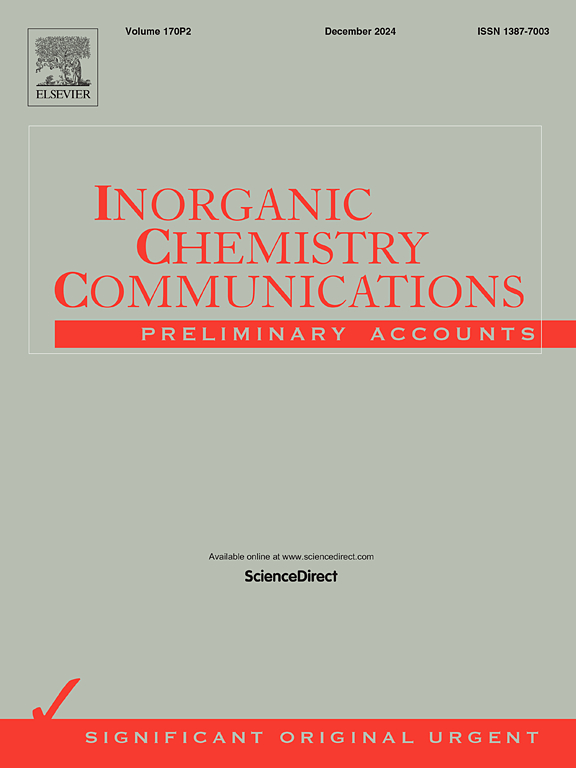硫掺杂CuCr2O4纳米催化剂的简易制备:用于增强双官能团析氧和析氢反应
IF 4.4
3区 化学
Q1 CHEMISTRY, INORGANIC & NUCLEAR
引用次数: 0
摘要
化石燃料在能源领域占主导地位,但它们的储量正面临急剧下降,并对全球气候构成严重威胁。因此,氢因其在各个领域的能源解决方案中的潜力而受到关注。本文采用水热法在不同温度下制备了S-CuCr2O4,并对其进行了结构、形态和元素分析等表征。随着水热时间的延长,S-CuCr2O4-3呈现纳米片状形貌。因此,本研究强调硫掺杂和调整CuCr2O4在析氧反应(OER)和析氢反应(HER)中的电催化性能的重要性,提出了一种稳定、高效的双功能水裂解催化剂。S-CuCr2O4-3的电化学OER活性最好,在10 mA cm−2下起始电位为146 mV,过电位最低为230 mV, OER的Tafel斜率为49 mVdec−1。通过计时电流法进行的耐久性试验表明,S-CuCr2O4-3具有良好的稳定性。此外,还测试了S-CuCr2O4-3的电化学HER活性,显示出90 mV的起始电位和251 mV的过电位,与纯CuCr2O4相比表现出明显更好的性能。因此,本研究为开发廉价、资源丰富的电催化剂开辟了一条新的途径。本文章由计算机程序翻译,如有差异,请以英文原文为准。

Facile fabrication of Sulfur-Doped CuCr2O4 Nanocatalysts: For enhanced bifunctional oxygen and hydrogen evolution reactions
Fossil fuels dominate the energy sector but they are facing sharp decline in their reservoirs and pose severe threats to global climate. Therefore, hydrogen has gained attention for its potential in energy solutions across various sectors. Here in present work, we fabricated S-CuCr2O4 at various temperature via hydrothermal method, and then employed for various characterizations to confirm the structural, morphological, and elemental analysis. The S-CuCr2O4 shows the morphology like nanosheets with increasing the duration for hydrothermal process for S-CuCr2O4-3. Thus, this study emphasizes the importance of sulfur doping and tailoring the electrocatalytic properties of CuCr2O4 for both oxygen evolution reaction (OER) and hydrogen evolution reaction (HER), presenting a stable and a productive dual-functioning catalyst for water splitting. The electrochemical OER activity of S-CuCr2O4-3 exhibits the best catalytic activity with an onset potential of 146 mV with the lowest overpotential of 230 mV at 10 mA cm−2 having a Tafel slope of 49 mVdec−1 for OER. The durability test is performed via chronoamperometry demonstrate the good stability of S-CuCr2O4-3. Additionally, the electrochemical HER activity of S-CuCr2O4-3 is also examined, and exhibiting an onset potential of 90 mV having overpotential of 251 mV, showing significantly better performance compared to pure CuCr2O4. Hence, this research launches a new pathway for the progress of cheap and earth-abundant electrocatalyst for future applications.
求助全文
通过发布文献求助,成功后即可免费获取论文全文。
去求助
来源期刊

Inorganic Chemistry Communications
化学-无机化学与核化学
CiteScore
5.50
自引率
7.90%
发文量
1013
审稿时长
53 days
期刊介绍:
Launched in January 1998, Inorganic Chemistry Communications is an international journal dedicated to the rapid publication of short communications in the major areas of inorganic, organometallic and supramolecular chemistry. Topics include synthetic and reaction chemistry, kinetics and mechanisms of reactions, bioinorganic chemistry, photochemistry and the use of metal and organometallic compounds in stoichiometric and catalytic synthesis or organic compounds.
 求助内容:
求助内容: 应助结果提醒方式:
应助结果提醒方式:


